
Fr. George Proksch SVD
( Guru Gyan Prakash Sharman )
1904 - 1986
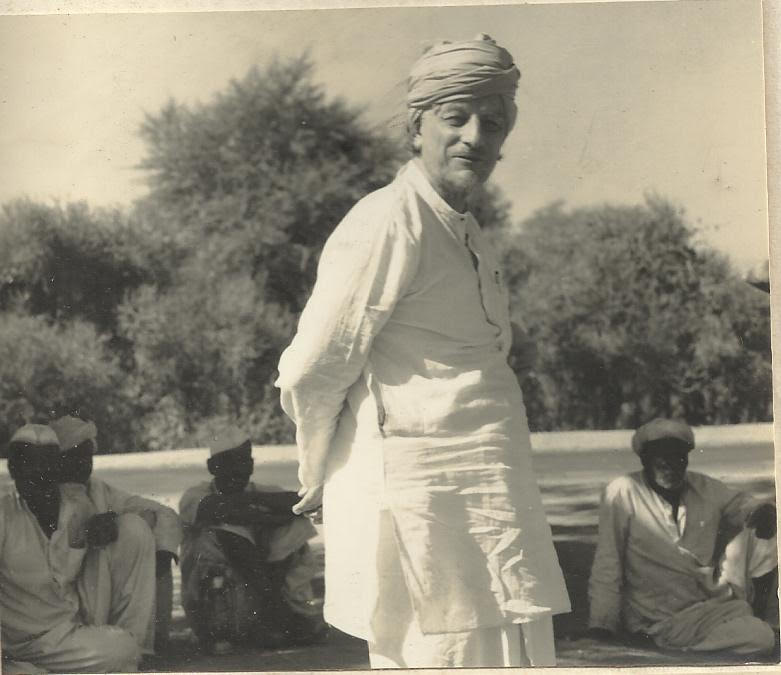 Fr. George Proksch
Fr. George Proksch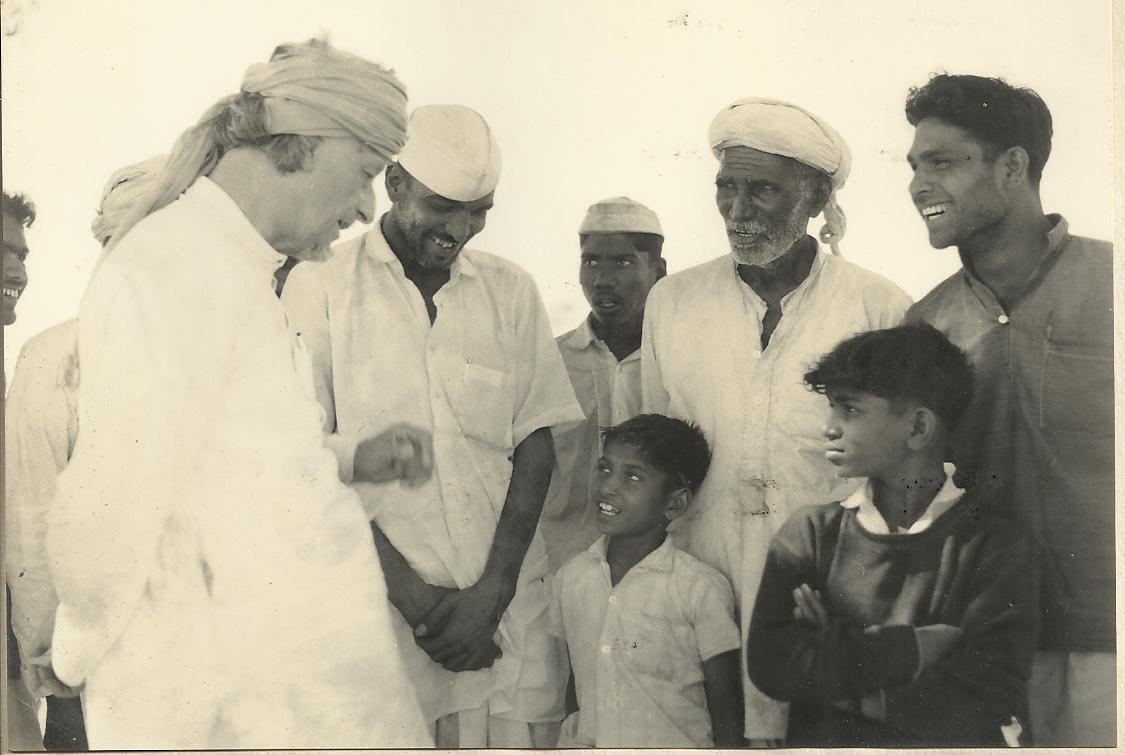 Fr. George Proksch
Fr. George Proksch Singing for the Pope -38th Eucharistic Congress held in 1964 at Oval Maidan, Bombay
Singing for the Pope -38th Eucharistic Congress held in 1964 at Oval Maidan, Bombay
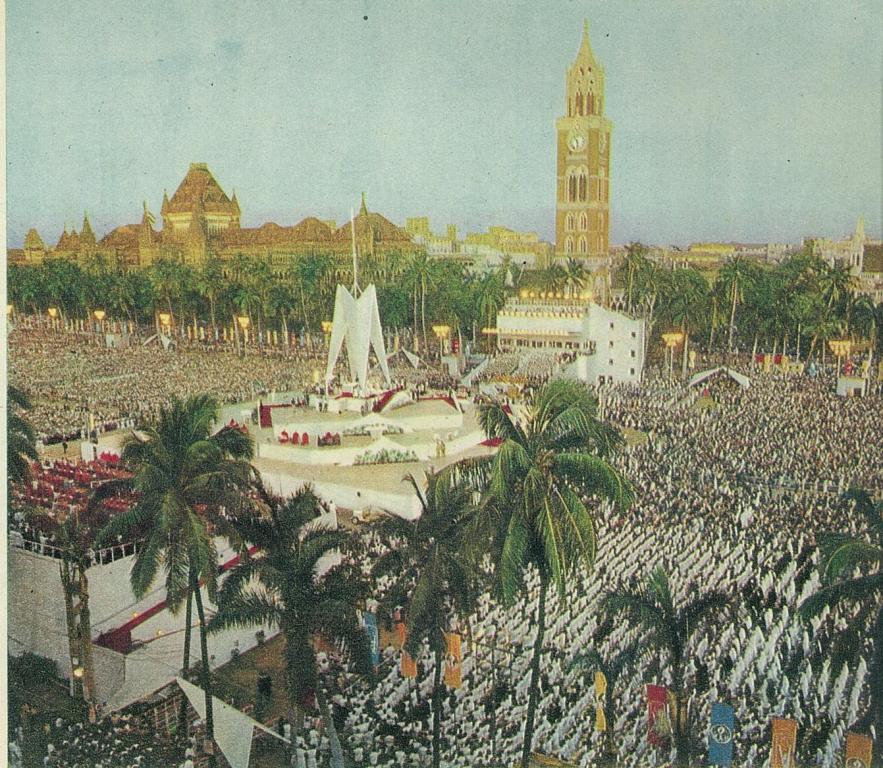 Singing for the Pope -38th Eucharistic Congress held in 1964 at Oval Maidan, Bombay
Singing for the Pope -38th Eucharistic Congress held in 1964 at Oval Maidan, Bombay
 Singing for the Pope -38th Eucharistic Congress held in 1964 at Oval Maidan, Bombay
Singing for the Pope -38th Eucharistic Congress held in 1964 at Oval Maidan, Bombay
 Singing for the Pope -38th Eucharistic Congress held in 1964 at Oval Maidan, Bombay
Singing for the Pope -38th Eucharistic Congress held in 1964 at Oval Maidan, Bombay
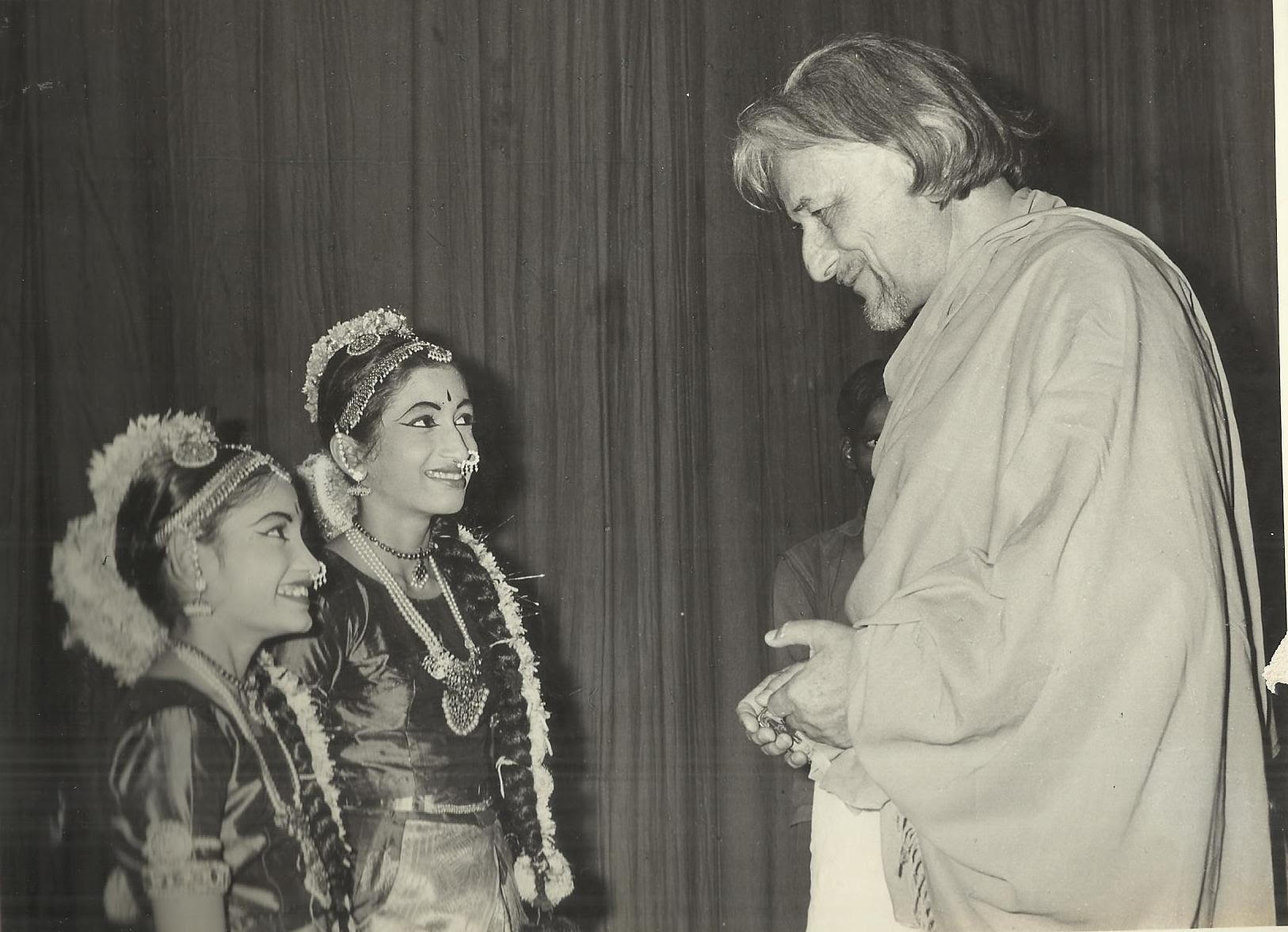 Fr. George Proksch
Fr. George Proksch
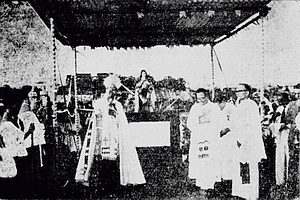 Laying of the Foundation Stone
Laying of the Foundation Stone
 Gyana- Ashramam
Gyana- Ashramam
A MAN OF VISION
Essar
Born in 1904 in Silesia, small town in Germany, young George grew in a picturesque surrounding filled with music and poetry. His father was a high ranking forest officer. George Proksch also got trained as a forest officer. This atmosphere was very conducive to develop his inborn talent in music, poetry and arts.
But his life took a different turn, as he felt the inner calling of God to dedicate his life totally to his service. So he pursued his studies in philosophy and theology,at the end of which he was ordained a priest in 1932. He was assigned to work.in India, a country totally alien to him, neither was he familiar with its rich ancient.culture nor was he aware of the multiplicity of its languages. To familiarise himself with at least one of its languages he spent one year studying Urdu at the Oriental Institute of Languages in London.
When arrived in India in 1933 together with his priestly, duties, he plunged himself in the learning of Hindi and Sanskrit. He was so impressed with the beauty of Indian culture, music, dance and art forms, that he totally identified himself with India and became a vocal exponent. of Indian music, dance and literature. His love for Hindi was so great that he once said "An Indian who does not know Hindi has no right to stay in India". He must have made this statement in his over enthusiasm to stress the importance of Hindi. But it reveals his love for Hindi. He has written over thirty books and booklets in Hindi. He wrote a few dramas,and poetry. His novel "Uskeliye" was well received. He was in personal contact with the leading literary figures of those days, including the great poet .Maithilisaran Gupta, Sumitranandan Pant and others. He wrote many plays for children which were successfully staged in several places. Among them, "Garibonka Mahal", " Andhkar me Prakash", "Chum Chanan Chumantar", "Kusum Kali", "Himani" etc. were outstanding. Perhaps his greatest literary work was "Kristayan", which he wrote while he was interned in prison during the second world war.
He was trained in western music. After his arrival in India, he mastered Hindustani Classical Music, dance and stage arts. He composed both religious and secular songs in various classical ragas. His collections of songs in "Rag Parag", Shraddanjali", "Bharat Geet", "Mangal Gaan" etc. have become very popular in the Hindi speaking areas.
In 1935, when he met Mahatma Gandhi at a Hindi Prachar meeting in Indore, he was so impressed with Gandhiji that he wrote in his diary-" Today I met a man who is able to hypnotize, because his is the image of a man of God. His life bore the seal of the ancient Ashram Ideal. He seems to move between 'tapasya' and 'swadhya' (meditation). This seems to be the secret of his successful proclamation". This impression had a lasting effect on his thought and activity, which unfolded in due course of time
At first, his field of work was Indore in Madhya Pradesh.Then he shifted to Bombay where he began lecturing in Hindi and Indian music. In 1949, he set up a registered Trust, Hindi Sanskrit Sangarn, to propogate and promote Indian culture, and provide facilities for the study of Indian languages,.literature, music and dance. At the same time, he was also actively pursuing his long standing.desire of establishing an ashram. It was not easy as this venture was not easily understood and supported by his higher superiors. He did not give up the idea. but was gradually able to get the necessary approval and he founded the ashram on a hillock on the Mahakali Road, Andheri, Bombay.
In 1956, he got the first big opportunity to present Christian themes in Indian art forms. On the occasion of Marian Congress he used folk as well as temple dances and Hindustani classical ragas to express Marian concepts. Cardinal Gracias had this to say about the impact of the Performance - 'Perhaps India will lend a readier ear to the message of Christ if it is presented in the form that has for ages been the favorite means of expressing religious thought and sentiment'. With the next cultural presentation at the 37th International Eucharistic Congress at Munich in 1960, Fr. Proksch created history when his ballet’Eucharist and Charity', employing Indian dancers and music was performed in the presence of the Holy Eucharist.
In 1964 the Eucharistic Congress held in Bombay marked a climax in the life of Fr. Proksch when 300 dancers and 1000 singers trained by him, presented 'Anant Prem'- the manifestation of God's love for mankind as seen in the Old and New Testament. Reviewing the show, 'The Sunday Standard', Bombay wrote - "It needed a remarkable German priest to introduce so forcefully Indian culture to Indian catholics. Quite a few of them were genuinely and pleasentlysurprised that Indian dance and ballet could not only be so enchanting, but so naturally adopted to Christian religious themes".
Besides these major presentations, the Ashram inmates led by Fr. Proksch have toured extensively in India and abroad. They have presented shows in Banaras, Allahabad, Lucknow, Agra, Gwalior, New Delhi, Ajmer, Udaipur and other cities bringing Christianity to mostly non-Catholics.
The themes of these presentations have been love of God, redemption, God as a shepherd and so on. The performers have portrayed these themes as well as the story of Christ who came from the Father to redeem all mankind without exception. Fr. Proksch prepared a programme called The Life of Christ', excerpts from which were broadcast by All India Radio, Bombay, during 1962 Christmas.
Fr. Proksch's achievements were recognized here and abroad. He was often invited to lectures and, presented his shows at international gatherings. When he attended the International Music Conference at Cologne in 1961, he expounded the richness of Indian music to an august audience of world renowned musicians. He said the Indian classical music was nearer to the Church music than even the music of Beethoven and Mozart. He remarked that the western music had nothing to match the aesthetic and spiritual qualities of ragas like Bhairavi and Jogia
On his 60th birthday, his friends and admirers organized a public function and presented him with a 'Abhinandan Granth'. Mrs. Vijayalaxmi Pandit, the then Governor of Maharashtra, presided over the function.
The pioneer, who made India his home, who fell in love with Indian culture, music, literature and art, breathed his last on May 30, 1986.
Our Homage to Guruji
You enlightened our path Loud and clear was your sing
“Jaga kekonekone me Aaojyotijala de ….”
- PRAYER
- SWARANJALI
- SURYA STUTI — The canticle of sun which St. Fracis sang in praise ' of God's creation.
- WELCOME SPEECH BY FR. FRANCIS—BARBOZA S.V.D.
- DR. LOUIS D'SILVA
- REV FR. JOSEPH PANTHALATI, S.V.D.
- CHIEF GUEST — RT. REV. DR. FERDINAND FONSECA
- VOTE OF THANKS BY MISS SOPHIE D'SOUZA.
INTERVAL
- THE DANCE — DRAMA MESHPAL BHAGWAN'.
Meshpal Bhagawan
This is the story of God's LOVE for man.
I
In the beginning was the Word and the Word was with God and the Word was God. All that came to be had life in Him and the life was the light of man.
In His love God created man.Unto his own image and likeness He created him. The new creation sings the praises of tike Lord.
In this happy world entered the tempter, the spirit of darkness, the enemy of the Father of light; and he knowing that mankind was free to do what it would, tempted our first parents to rebel against God. And they did rebel. They sinned against the light and all was lost. Sin entered the world and along with sin, sorrow and death.
But God is great and good. His love has no limit, moved with pity f- - his children, now enslaved in sin and incapable of delivering themselves. He sent his latest and greatest gift, salvation in fulfilment of his promise of old: I shall send a Redeemer who will crush the head of Satan.
II
In the precise year of God's choosing salvation came to the human race in the form of an avatar. Jesus Christ. He came through a spotless virgin in spite of the wild shouts of Satan and his followers. The virgin conceived a child and the child she bore was God made man. He will be known as the Messiah-Shepherd. His mother sings a tong of praise and thanks in honour of the Lord who has showered such great love upon us.
III
The Shepherd Redeemer was born. Shepherds danced their way to greet the Redeemer.
But again arrives the Spirit of darkness who offers his own plan of redemption in the midst of the devilish exhibition the Lord appears as the simple Shepherd-Redeemer! doing good wherever he goes.
He heals the sick, preaching good tidings of love to the poor, forgives sinners and helps where help is needed.
After the mission of love is done the very people who have received the love of the shepherd God.
Crucify him. But he rises to life again to prove his divine mission, his mission of love to men.
To lave his perpetual memory among men. Jesus Christ demonstrates his lesson of love by washing the feet of his disciples
This is my command, my last Guru mantra to you and to all:
Serve. Love through service!
Glimpses into Gurji's Life
"Son you make the land of the Ganges the venue of your work." This prophecy of a mother came true when Fr. George Proksch, born in 1904 in Sylisia, travelled from Vienna to India in 1933, after he was ordained a priest on the 5th of May 1932.
Since childhood, Father Proksch had been deeply interested in the fine arts and literature and had excelled himself as an actor, singer and director in vienna before receiving the holy orders in 1932.
When he came to India he was wonderstruck by its rich cultural, heritage and immense potentialities of Indian Music and dance. He had witnessed the country's sages and saints conveying the truth of religion through song and dramatic representation in form of Kathas, Ramlilas and Raslilas.
Fr. Proksch perceived intensely the potentialities of combining the riches of the Gospel and the wealth of Indian art to portray and project Christ to India in a medium that would he both attractive and appealing. And so 50 years ago Fr. Proksch set out on the quest to introduce Indian Music and Dance to the Church and to incorporate them, it possible into the texture of the Church's life in the country. It was a solitary quest indeed, encountering stiff and determined opposition, misjudged, misinterpreted, yet among the clouds of opposition there was a ray of hope in a staunch and consistent supporter Cardinal Valerian Gracias. And so the visionary pressed on studying, reflecting, seeking light.
The first real break came on the occasion of the National Marian Congress in 1956. The Marian dance drama proved to be a real revelation. "Tera Noor", took Bombay and Catholic India by storm. Cardinal Gracias voiced the feelings of thousands when he declared : "One of the proudest moments of my episcopate is this experience than we Catholics can present the christian mysteries so impressively in an Indian style." in 1960 Fr. Proksch created history, when atthe International EncharisticCongress at Munich, for the first time in liturgy, the dancers performed in the presence of the Holy Eucharist.
And then of course in 1964 there was that spectacular dance-drama `Parmottam Prem', "No Greater Love", during the Bombay Eucharistic Congress. Critics vied with each other to sing its praises. But a non-christian columnist brought out the lesson of it all simply and catagorically : "Fr. Proksch has for long insisted that the story of Christ should and could be interpreted in a purely Indian idiom and setting. In the ballet "No Greater Love," he has proved his contention" (Sunday Standard Dec. 6, 1964). A scholar of Hindi, Sanskrit, and Hindustani Music Fr. Proksch has written novels, essays, plays, hymns, devotional songs, patriotic songs and dance - dramas. His literary and musical works number about forty and include a life of christ "Kristayan" — which he wrote during his internment at Devlali Camp. One of his crowning works is the 'MangalGaan' — a poetic translation of the Psalms in Hindi. The pioneering effort of Fr. Proksch, his indomitable will to succeed, coupled with zealous persuit of and honest commitment to whatever is good and beautiful in Indian Culture, brought him to the notice of the leading exponents of Indian art and literary, luminaries who looked with wonder at the brave new world of art that he was creating — Indian Christian Art — They applauded his effort and presented him with a 'Book of Tribute'. "AbhinandanGranth".
Fr. Proksch travelled east, west, north and south, in India and abroad, with the Gyan Ashram Group which he founded in order to spread the truths of the Gospel in a way which was his own.
In 1982, the German-Government conferred on him the award — "BundesVerdienstKreuzersteklasse", — for bridging the gulf between East and West.
A Zealons Missionary who never knew rest, rested on the 30th of May 1986. When on 6th of June, 1986 his mortal remains were taken to the tomb, his immortal tunes resounded 'Tera Noor' and `DildarPyare Jesu'. Someone has rightly said 'such a great soul comes only once in a few centuries and the world is influenced them for many decades.
Remembering Fr. George Proksch
Arnoldus Nota
The professors and students of the Gyan Ashram, Bombay celebrated the 92nd anniversary of the birth of Fr.George Proksch on 10 February. Fr.Proksch, founder of the ashram, died in St. Gabriel in 1986.
Fr.Stephen Fuchs (88), who has since retired to St. Gabriel opened the celebration by unveiling a bust of the lately deceased Guru Gyan Prakash Sharman, as Fr.Proksch was called in Hindi. This was followed by a performance of the Aradhana ceremony by seven students of Fr. Francis Barboza, who has followed the footsteps of Fr. Proksch and studied Indian dance. Fr John Paul Hermann, who is writing his doctoral thesis on Fr. Proksch, summed up his life and work, while Fr. Norbert Hermann sang two of the Indian bhajans (songs) composed by Fr. Proksch. The tenth anniversary of Fr.Proksch's death was on 30th May.
Fr. Proksch (1904-1986) came to India shortly after his ordination (1932). He began his work among the Bhils in what is now the diocese of Indore, using the then normal methods of evangelization which took very little account of the thought and the culture of India. But the uselessness and lack of results of this form of evangelization soon became clear to Fr. Proksch.
He then began to observe more closely the methods used by the Hindu preachers. They spread their religious teaching primarily through dramas performed in dance and song. People, who had worked all day long under the burning sun, could watch and listen to these sermons late into the night, without falling asleep! Would it not be possible to preach the truths of the Christian faith in a similar way? Fr. Proksch found little response to such questions among his confreres. But he did not give up. He began to prepare himself systematically for this form of apostolate. He undertook the necessary studies in Hindi, Sanskrit, etc., studied the forms and rules of the native dances and songs, and learnt how to play traditional Indian instruments.
In the foot steps! Fr. Proksch (Left) and Fr. Carlo Interned by the British, during World War ll, the German-bom Fr.Proksch made good use of the time by improving his knowledge of Indian languages. In the following years he wrote a life of Jesus in Hindi, gathered Indian melodies and set them to Christian texts. He also composed melodies himself, inspired by Indian music. Some of them were received so well that they later become popular songs.
An Indian secular priest, who got to know his work, became his particular friend and supporter. Valerian Gracias, later Archbishop of Bombay and Cardinal. He called Fr.Proksch to Bombay. There he was able to open Gyan Ashram in the vicinity of Andheri in 1949. He gathered around him a group of like-minded Indian teachers who promoted his work. With their help he became the first European ever to study Sanskrit and Hindi at the University, Mysore. He completed his music studies in Bombay, and at the Music Academy in Lucknow. He thus built his work on a solid foundation.
His first attempt to express religious themes in dance, dates way back to 1935. But it was not until twenty years later that this attempt won recognition on a countrywide scale. This was when he staged a religious play in honour of the Mother of God at the National Marian Congress,in Bombay in 1954. The attention of the whole Christian world was drawn to his work when he performed a religious play called The Fruit of Death and the Bread of Life at the Eucharistic World Congress in Munich in 1960.
He wrote another religious play for the Eucharistic World Congress in Bombay in 1964: 1500 people attended its first performance. Christian faith was given an Indian garb. The ashram he founded was intended not only as a place of creative work, but also as an opportunity to give the necessary spiritual depth to his action.
When he personally experienced Mahatma Gandhi in Indore in 1935, he sensed that Gandhi's influence did not rest just on the use of certain cultural elemets of Indian culture, but on his as¬cetic personality. Fr. Proksch never forgot this lesson.
A number of his closest followers practised a serious religious life in the ashram he had founded, but he never succeeded in finding an appropriate struc¬ture in which to express it. His attempts to connect the ashram-idea with that of a secular institute proved fruitless. The re¬sult was that after his death this group quickly dissolved. Nor did Fr.Proksch succeed in founding a school which would develop the work he had initiated.
The confreres who work in the Ashram Gyan Prakash today are inspired by Fr.Proksch, but go their own separate ways: -
- Fr.Dr.FrancisBarboza studied classical Indian dance and tries to express Christian doctrines and beliefs through it.
- Fr.Charles Vas is more specialized in the ethnic elements of Indian song-culture. His compositions have been widely diffused among the people through many cassettes.
- Fr.Gilbert Carlo tries to make Christian spirituality accessble to Indians with the help of yoga and Indian methods of meditation.
(Arnoldus Nota)
India
18&19 -August 1996
Singing for the Pope
Naresh Fernandes
At 5.15 pm on December 2, 1964, Bombay poured into the streets to greet a famous visitor: Pope Paul VI. “Pilgrim of peace gets tumultuous welcome: 15-deep cheering crowds pack streets,” said the Times of India’s headline. Both Prime Minister Lal Bahadur Shastri and Vice President Zakir Hussain were on the tarmac at Santa Cruz airport as the Pope stepped out of the plane, joining his hands to say “Namaste”. As his open Ford convertible made its way south, passing through streets decorated with archways and bunting, more than a million people of lined his route.
“Every vantage point – tops of buses, scaffolding, incomplete cement structures, trees, terraces, galleries, improvised platforms – was packed with people,” reported the Times. “The surging crowds threw the elaborately-planned police arrangements into confusion.” The crowds were so thick, it was already dusk by the time the motorcade had got to Prabhadevi. It took more than two hours for the Pope to reach the Oval, his destination.
Paul VI was in the city to attend the Eucharistic Congress, a Roman Catholic conference held periodically in various parts of the world. The Bombay congress, the 38th edition, was attended by several hundred thousand people, including 20,000 overseas delegates. The meeting aimed to project the idea of a “servant Church”, which, a Jesuit weekly explained, emphasised the image of “a Christ born poor – more at home in the slums of Bombay than in the magnificence of a papal court”. It also attempted to foster the idea of ecumenism, reaching for dialogue with people of all India’s religions.
Preparations for the Eucharistic Congress had proceeded for almost two years before the event. Special attention had been paid to the musical accompaniment to the various services that would proceed at the Oval Maidan, which had been converted into an open-air cathedral. Eighteen months before the event, a special Congress hymnal was issued to school and parish choirs, so that they could learn the tunes and help the congregation at the Oval participate more completely. In addition, a 1,000-voice Polyphonic and Gregorian choir was assembled under the baton of Father JB Fernandes. It held several practice sessions at a stadium in Parel.
A few months ago, I found a recording of some of the pieces performed at the Congress. It features the Congress Hymn, composed for the occasion by the Bombay musicologist Antsher Lobo. In keeping with the Church’s efforts to demonstrate its deep Indian roots, there are also songs in Hindi, Marathi, Konkani and Gujarati. (The EP was retrieved from a shop in Chor Bazaar, so it’s scratchy and when my friend Ajay Noronha digitised it, it decided to skip a little.)
On the sidelines of the conference, a three-act ballet about the life of Christ titled AnutamPrem (No Greater Love) was staged for several nights at the Brabourne Stadium. It featured 300 dancers, 250 musicians and 1,000 singers. It had been composed and choreographed by a Sanskrit scholar named Father George Proksch, who had assumed the name Guru Gyan Prakash. In addition, sitar maestro Ravi Shankar created a musical show called In the Beginning Was Sound
The Pope seemed to have been rather impressed by his trip. As he departed three days later, he told the crowds, “We return to Rome bearing with us an unforgettable memory of our pilgrimage…here we leave our heart.” (Click here for footage of the visit.)
Jazz tangent: Louis Armstrong performed in Bombay exactly when the Eucharistic Congress was being held. This caused no end of consternation for people who worshipped both jazz and the Lord. But since Armstrong made two appearances, at Shanmukhananda Hall and at Rang Bhavan, fervent Catholic fans had the option of attending the Papal mass one day and seeing Satchmo the other.
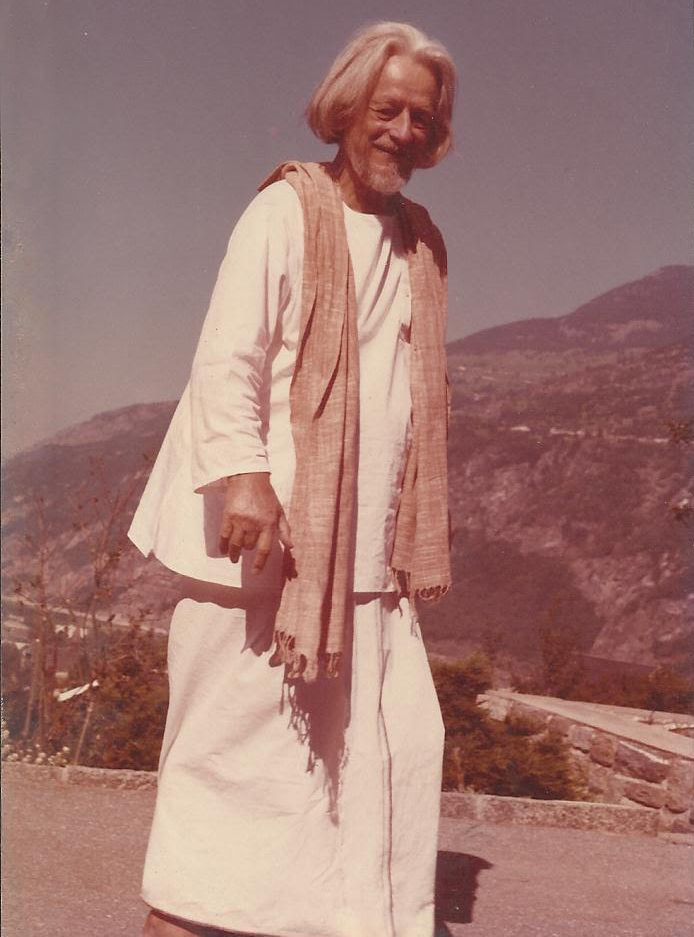 Fr. George Proksch
Fr. George Proksch
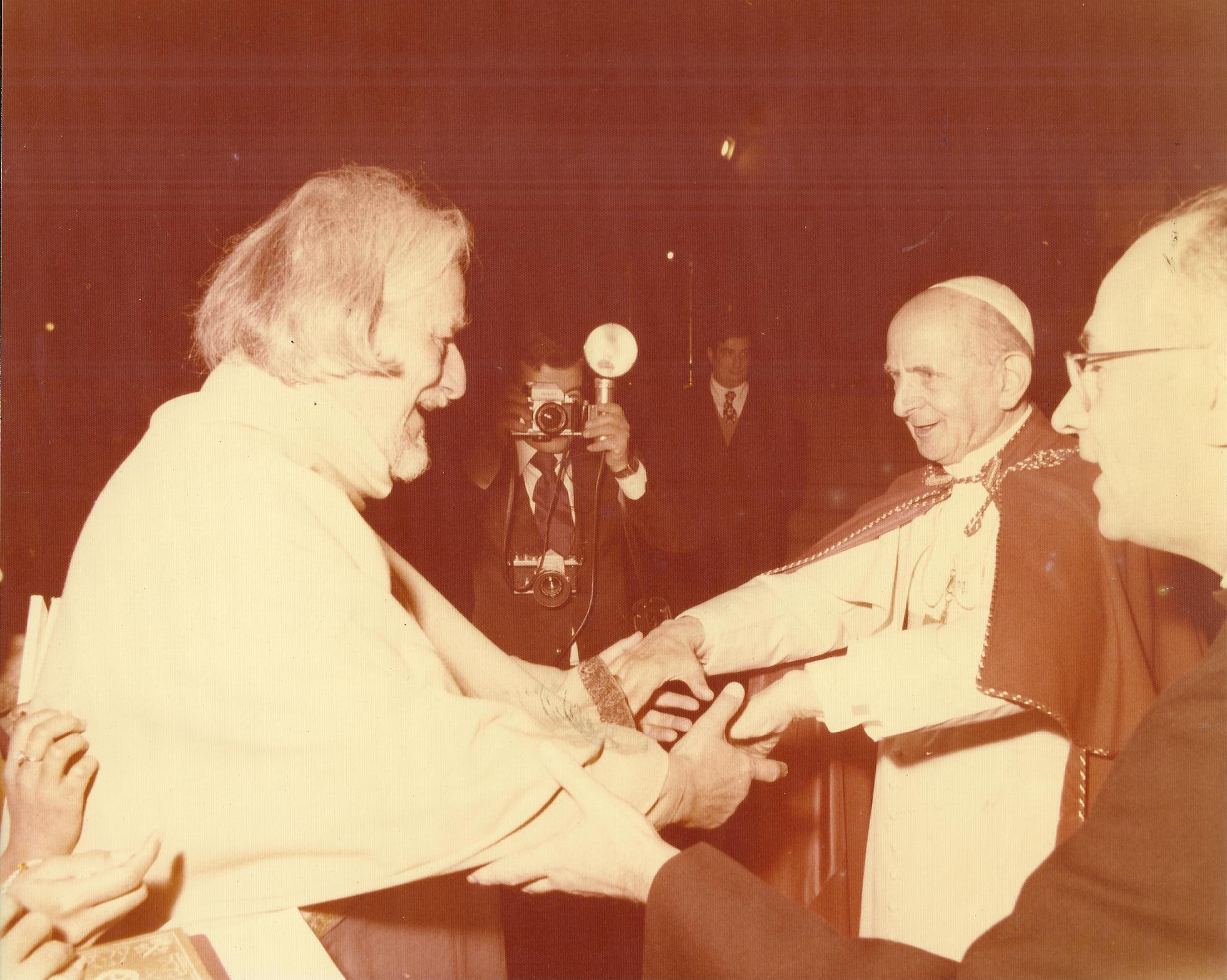 Fr. George Proksch
Fr. George Proksch
 Fr. George Proksch
Fr. George Proksch  Fr. George Proksch with Fr. Carlo
Fr. George Proksch with Fr. Carlo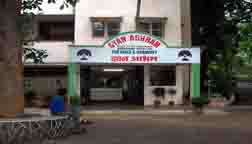 Fr. George Proksch - Gyana Ashramam, Mumbai
Fr. George Proksch - Gyana Ashramam, Mumbai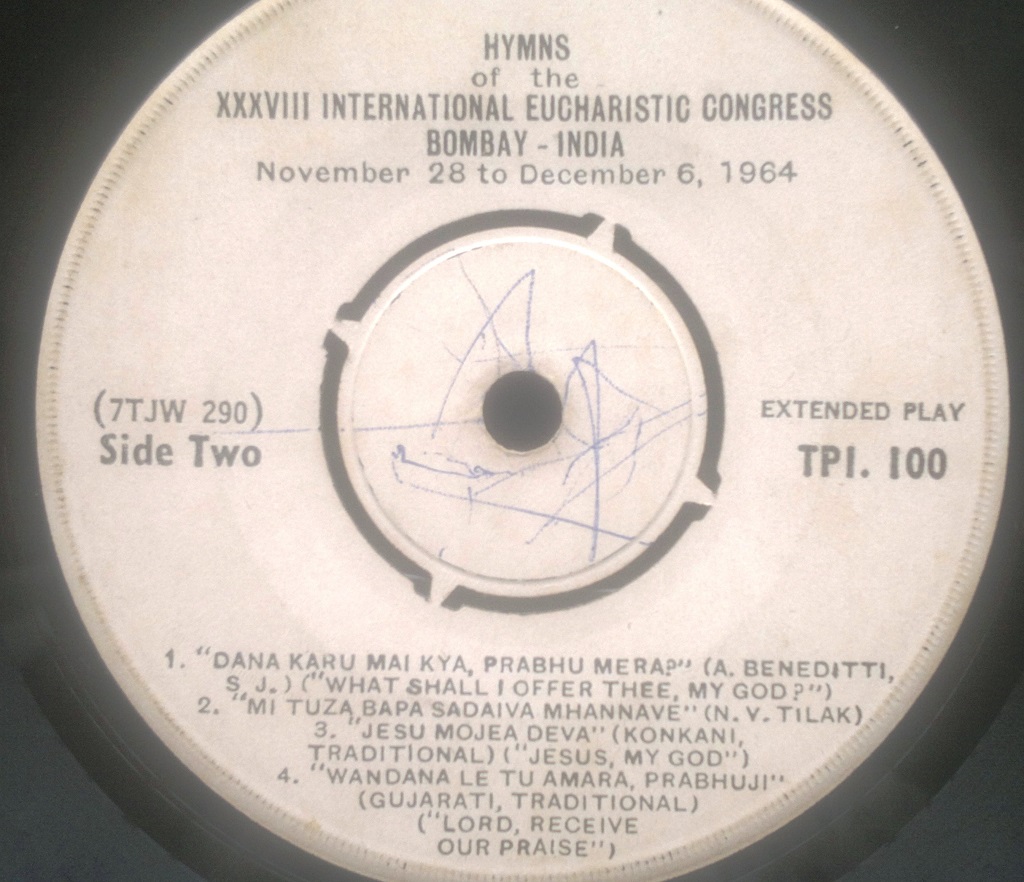 Singing for the Pope - Hymns of the 38th Eucharistic Congress held in 1964 at Oval Maidan, Bombay
Singing for the Pope - Hymns of the 38th Eucharistic Congress held in 1964 at Oval Maidan, Bombay
 Fr. George Proksch -Gyana Asharam
Fr. George Proksch -Gyana Asharam 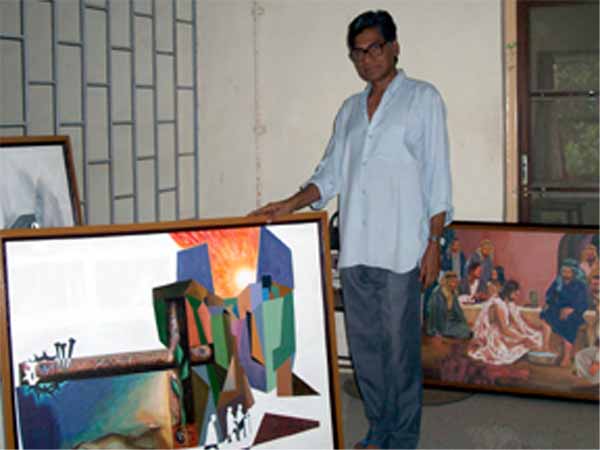 Gyana Asharam, Mumbai
Gyana Asharam, MumbaiGyan Asharam
Founding of the First Indian Catholic Ashram 1948
The inspiration of Mahatma Gandhiji (1869) at a Hindi Prachar meeting at Indore in 1935 in which Fr. G. Proksch was also a participant, triggered off the gigantic task which he accomplished for the Church in India during the following years. Inspire of adverse surroundings and circumstances. Fr. G. Prakash realized the need to establish an abode to proclaim the message of the gospel to the Indian tradition. Christian ideals, to proclaim the message of the gospel to the Indian masses.Fr.G.Proksch wrote, “Today I met a man who is able to hypnotise, because he is the image of a man of God. His life bore the seal of the ancient Ashram ideal. He seems to move between Tapasya self discipline his successful proclamation. With these two ideals of self-discipline and sacred meditation he established the “Gyan Prakash Ashram”. Life in this “Ashram” meant a chaste community living a never failing warmth of understanding to all persons simple living with contemplating on the Sacred Scriptures culminating in the celebration of the Holy Eucharist. The specific aim of this Ashram was the Proclamation of the Word in Indian art and form in a way that was true to Indian culture and understandable to Indian people. This was the Ad Gentes initiated as early as in the year 1935 by Fr. G. Proskch.
Guru Gyan Prakash as he was commonly known by his Indian name claimed that the gospel message in India would not make any impact on the Indian people as long as this message was imported from Europe. When he came to India in 1932 he had no Bhajans, Hymns or Kathas (sacred narrations) to preach like the century old Gurus of India. This forced him to study Indian languages. Hindi and Sanskrit, the sacred literature of the Hindus, the Vedas Upanishads and Puranas. He learnt a number of different folk dances, folk songs and a series of ragas of Indian music along with different Indian instruments like the Veena (Harp) and sitar, Sarod or Bansuri (Flute). During a number of which he attended with Mahatma Gandhiji, he was able to discuss the thinking of Indian people and their culture.
This was again another missionary approach by Fr. G.Proksch. The establishment of an Indian form for the people in India and make available Catholic literature and material presented in Indian dance and music for the missionaries working in India. Fr.G.Proksch found little or no support in the early days; there were bishops and priests and even his own confreres who doubt his intentions and feared that he was turning Christianity into Hinduism; moreover this missionary method and idea did not conform to what other missionaries were busy with. Being convinced of this method, he finally got a temporary approval of his religious superiors and with the interest of an Indian priest Fr. Valerian Gracias, experimented in presenting Christian themes in Indian art and form.;
This was again another missionary approach by Fr.G.Proksch. The establishment of an Indian form for the people in India and make available Catholic literature and material presented in Indian dance and music for the missionaries working in India. Fr.G.Proksch found little or no support in the early days; there were bishops and priests and even his own confreres who doubt his intentions and feared that he was turning Christianity into Hinduism; moreover this missionary method and idea did not conform to what other missionaries were busy with. Being convinced of this method, he finally got a temporary approval of his religious superiors and with the interest of an Indian priest Fr. Valerian Gracias, experimented in presenting Christian themes in Indian art and form.
The themes and context of the dances and dramas depicted the conflict between good and evil, light and darkness, life and death, a series of great. Hindu dramas like Ramlila and Mahabharata, besides these, there were Catholic themes focused on the unending love (Anupam Prema) Christ the good shepherd (Mesphal Bhagwan) the promise of the Messiah, his life on earth, his suffering and death on the cross, the triumph of the resurrection with the ascension to heaven as conquering death and darkness. One reads in history of his first public presentation to an audience of 30,000 people at the Marian Congress held in Bombay in December 1954, where he depicted the Marian Mystery in six scenes: paradise, the fall, the shout of lost humanity, the promise of Mary, the immaculate conception and the annunciation; thereafter in several other mission areas of India, where the Good Shepherd theme became very popular; several performances in Europe, and the presentation of a special ballet, performed by 300 dancers and 250 musicians and 1000 singers, prepared for the XXXVIII International Eucharistic Congress at Bombay, in the year 1964, which was attended by Pope Paul VI, presented to an audience of 60,000 people. It must be acknowledged that for the first time, Catholic hymns were sung in Hindi in the Churches of Bombay and elsewhere, many of whose words and melody are tracked back to Fr.G.Proksch. The most famous were the hymns Shri Jesu Bhagawan and Tera NurJagameHuwa Hai Fr.G.Proksch can rightly be called the greatest pioneer of our times
The Gyan Ashram, Andheri, Bombay
George Proksch wanted to give mission work another dimension. His name is Gyan Prakash, Gyan meaning knowledge, knowledge of Christ and Prakash meaning light/revelation. Song and dance is his material, he tries to religiously educate the Indian people.” This was a remark of an eminent guest at the Gyan Ashram after the performance of the Mesphal Bhagvan during the 38th International Eucharistic Congress. Fr. G. Proksch had already founded a Catholic Ashram and had given precedence for this kind of a missionary method in India. This ashram once thought of as a novelty in Catholic circles in India soon became a reality of great significance.
Life in this ashram equally called for tapasya penance a centre living, an option for simplicity in food clothing and demand a meaningful silence. The personal study and understanding of the Sacred Scriptures a swadhyaya, in Catholic missionary perspective this was the study of the Holy Bible. The sacrifice and offering to the Almighty upasna was the celebration of the Holy Eucharist Sewa Prem was expressed to all who entered the ashram with the motive to bring them closer to Jesus Christ. Besides this meaningful way of life another aim of the ashram was to train lay persons to proclaim the gospel message of salvation in Indian form for the people in India, and to make available Catholic literature and material presented in Indian dance and music for missionaries working in India
To facilitate this work Fr. G. Proksch received an affiliation from the Lucknow University toward academic degrees in Indian music. The ashram was also seen as a learning centre which attracted non Catholic to learn Indian dance and music and these skills were used to present biblical themes. One reads in the history of the ashram that examinations were annually conducted by a professor from the Lucknow University Music College, and for the year 1968 there were more than 35 students.
The Ashram Way of Life
Life in an Ashram is no new way of spiritual asceticism in India. It was traditionally the place where a hermit lived where his disciples gathered around him. One reads in history that Indian sages pursed their spiritual search in this way for centuries in the past, and in recent times the classical example of SwamyVivekanand may be cited in the non-Catholic Indian context, who after his concept of God and the ideal of Ramakrishna’s work founded an order of monks. The monk who was previously known as Naren initiated 140 spiritual centres, where more than 600 members were obliged to religiously meditate, to study philosophy and serve humanity.
It must be admitted that the form of the ashram in India has undergone changes. As against the beginning when ascetics sanyasis renounced the world, went into the forest, lived in solitude and contemplation with the Almighty in prayer and penance, to today’s ashrams which vary from single men living in caves or one room huts to others like the Ramakrishna Mission and the Divine Life Society, where the disciples undergo a formal religious training. Some centres, like the Belur Mutand Sivananda Ashram, have more than a hundred sanyasis living in a community. They run colleges, hospitals, and printing press and send their members even to Europe and America to propagate their ideology
The quest for the Almighty has always been part of the Indian mind, even several centuries before St. Benedict wrote his rule describing the purpose of monastic life as being to seek God there were hundreds of ashrams throughout the length and breadth of India, where men and women lived in the greatest simplicity under obedience to their guru spiritual guide, and dedicated themselves totally to this yearning and longing for the Almighty. Their spiritual yearning drove them insatiably to plunge into the interior mystery and to seek the inaffable presence of the Almighty.
Life in an ashram demands tapasya penance, which is the basis for ascetic living, making a basic option for a simple way of life, in food and clothing, and maintaining a meaningful silence. It demands a personal study and understanding of the Holy Scriptures adhyaya to absorb its contents and make it one’s own
Present Activities of the Institute
Painting
Dance : Bharatnatyam,Odissi, Kathak Music (vocal) :
Carnatic Sangeet Instrumentals : Harmonium, Casio and Guitar
Fitness Exercises : Yoga, Aerobics, Acting and Personality Development course.
Names and Year of SVD (Directors) worked / working
Fr. George Proksch : 1958 - 1984
Fr. BerlyPallan 2005
Mass Of The Holy Spirit
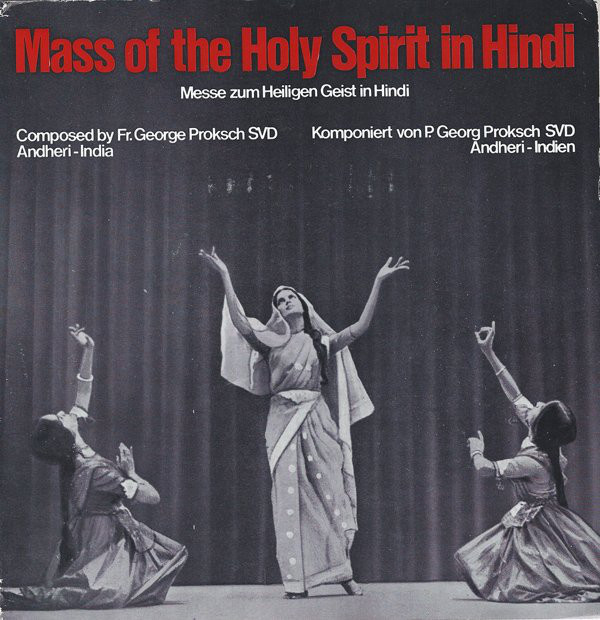 |
Mass Of The Holy Spirit In Hindi (Messe Zum Heiligen Geist ) - Fr. George Proksch SVD |
|
| Language | Hindi | |
| Label | Studio Union – MH 69 | |
| Format | Vinyl, 7", 45 RPM, Mono | |
| Country | Germany | |
| Released | ||
| Genre | Folk, World, & Country | |
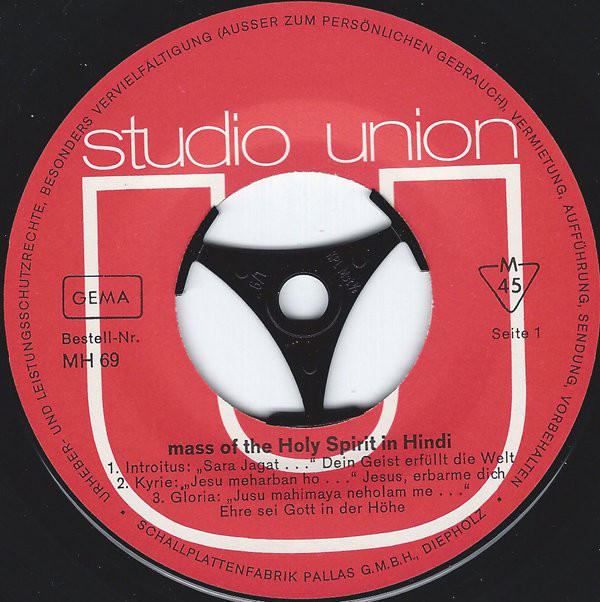
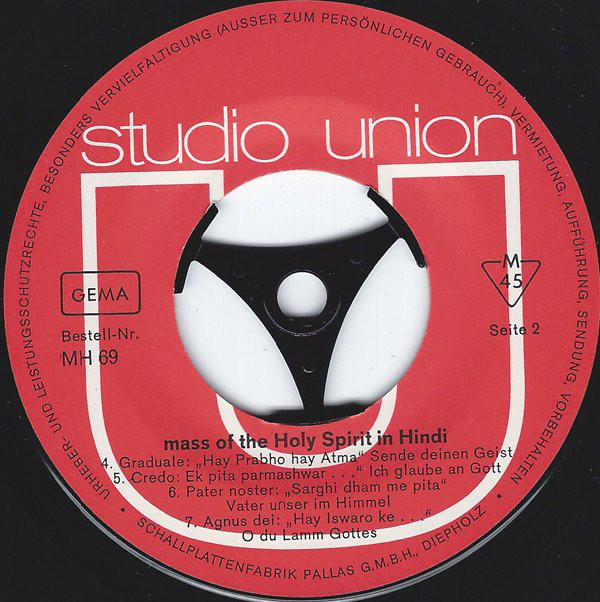
Tracklist
| Track # | Song |
| A1 | Introitus: "Sara Jagat..." Die Ganze Welt Ist Erfüllt Von Deinem Geist |
| A2 | Kyrie Eleison: "Jusu Meharban Ho..." Jesus, Erbarme Dich |
| A3 | Gloria: "Jusu Mahimaya Neholam Me..." Ehre Sei Gott In Der Höhe |
| B1 | Credo: "Ek Pita Parmashwar" Ich Glaube An Den Einen Gott |
| B2 | Graduale: "Hay Prabho Hay Atma..." Sende Aus Deinen Geist |
| B3 | Pater Noster: "Sarghi Dhamme Pita..." Vater Unser Im Himmel |
| B4 | Agnus Dei: "Hay Iswaro Ke..." O Du Lamm Gottes |
Companies, etc
- Manufactured By – Schallplattenfabrik Pallas Gmb
Credits
- Composed By – Fr. George Proksch SVD*
- Vocals – Pupils Of The Gyan-Ashram-Institute Andheri
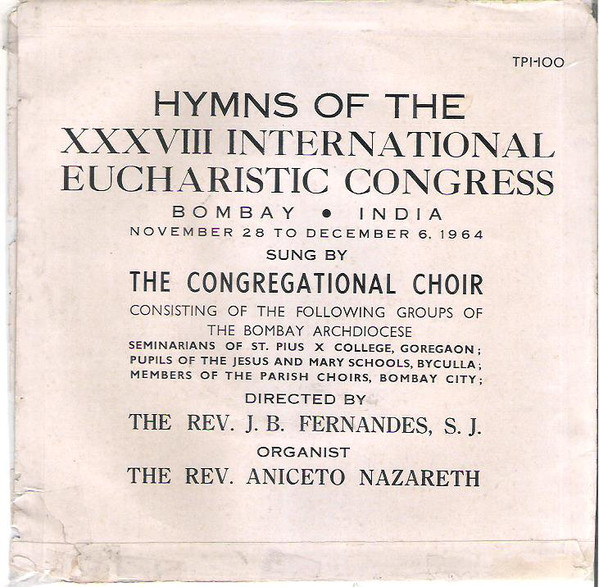 38th Eucharistic Congress held in 1964 at Oval Maidan, Bombay
38th Eucharistic Congress held in 1964 at Oval Maidan, Bombay  Fr. George Proksch -Gyana Asharam
Fr. George Proksch -Gyana Asharam 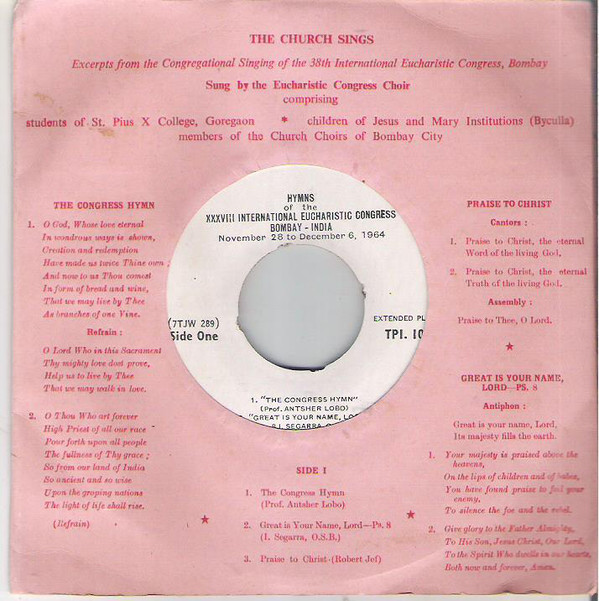 38th Eucharistic Congress held in 1964 at Oval Maidan, Bombay
38th Eucharistic Congress held in 1964 at Oval Maidan, Bombay 
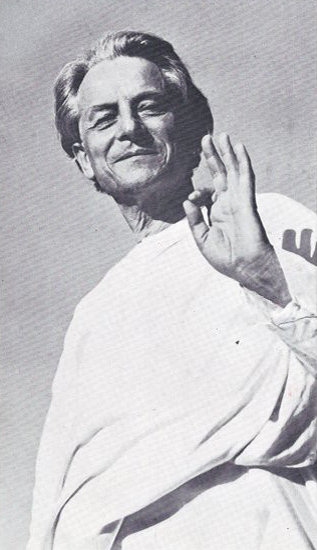 Mass of the Holy Spirit by - Fr. George Proksch SVD in Hindi
Mass of the Holy Spirit by - Fr. George Proksch SVD in Hindi
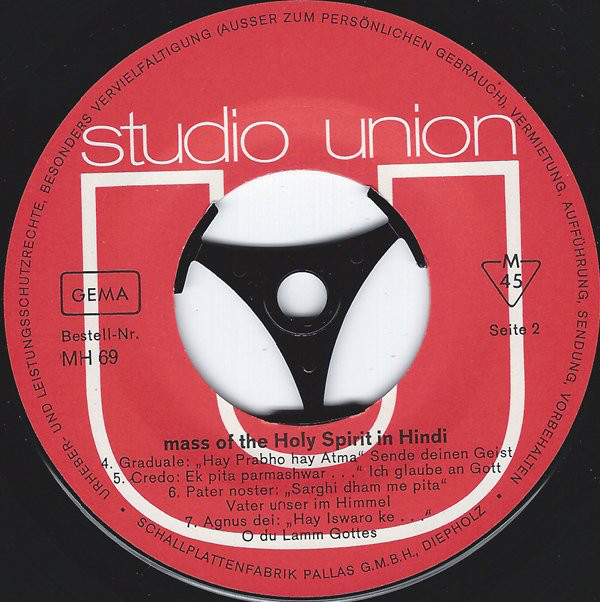 Mass of the Holy Spirit by - Fr. George Proksch SVD in Hindi - LP Disc
Mass of the Holy Spirit by - Fr. George Proksch SVD in Hindi - LP Disc
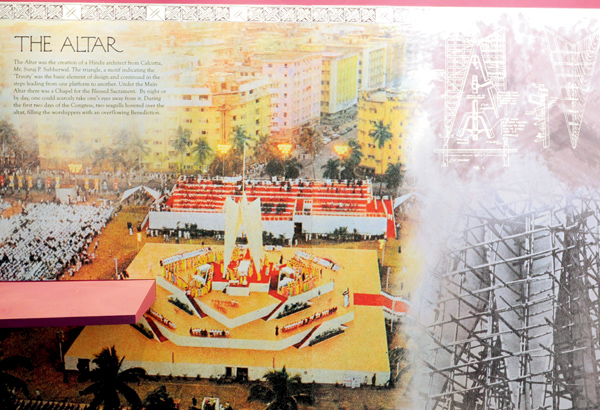 38th Eucharistic Congress held in 1964 at Oval Maidan, Bombay
38th Eucharistic Congress held in 1964 at Oval Maidan, Bombay  Pope visits- 38th Eucharistic Congress held in 1964 at Oval Maidan, Bombay
Pope visits- 38th Eucharistic Congress held in 1964 at Oval Maidan, Bombay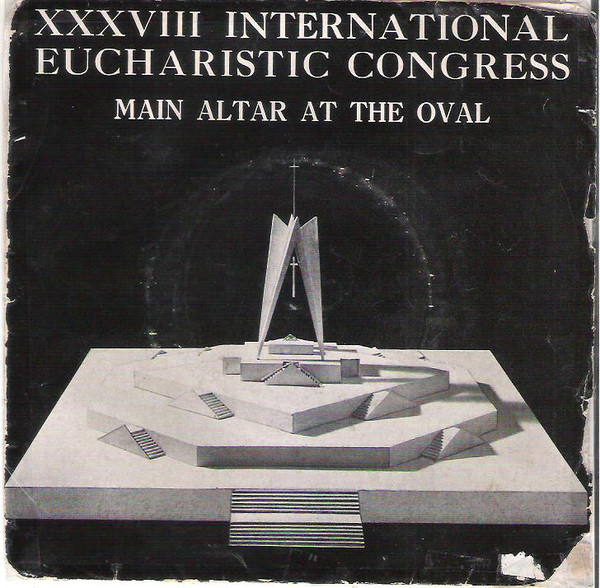 38th Eucharistic Congress held in 1964 at Oval Maidan, Bombay
38th Eucharistic Congress held in 1964 at Oval Maidan, Bombay